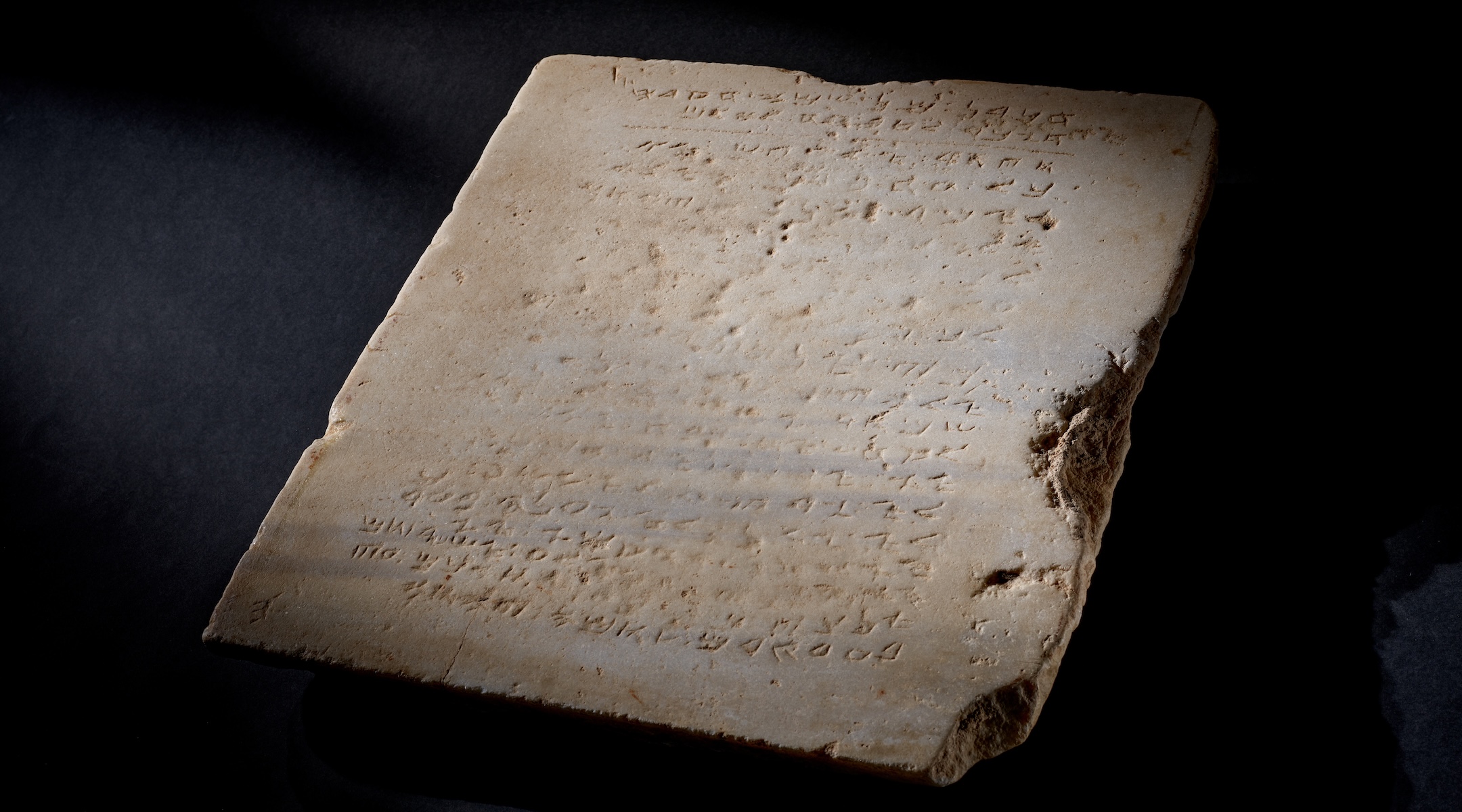The oldest stone inscription of the Ten Commandments will go up for auction next month, but with an important disclaimer: Israel allowed the 1,500-year-old tablet to leave the country 20 years ago only on condition that whoever owns it ensures that it’s always available for public display.
Sotheby’s is planning to note this history on the web page advertising the sale, according to Sharon Mintz, the senior Judaica specialist for the auction house.
Mintz said in an interview that she’d like to see the tablet end up with a public institution but that the terms of the sale do not include any such requirement.
Beyond the artifact’s cultural significance, its history and ultimate fate matter because of an ongoing reckoning over the antiquities trade, which has forced many collectors and museums to relinquish objects that had been looted from their country of origin.
The issue was far less prominent 20 years ago when an American rabbi named Shaul Shimon Deutsch requested a license to export the ancient Samaritan tablet. The Israel Antiquities Authority agreed, but only on the condition that the artifact be publicly displayed. Deutsch was allowed to sell it to a third party under the same condition. Deutsch complied, taking the tablet to his Living Torah Museum in Brooklyn.
The tablet remained there until 2016 when Deutsch decided to put it up for auction. As part of the sale, the requirements of the export license were publicized, and an anonymous buyer purchased the artifact for $850,000. After that, it disappeared.
Steven Fine, a history professor at Yeshiva University, attempted to track down the Ten Commandments tablet several years ago. He was gathering the most important ancient Samaritan artifacts from museums and libraries around the world for an exhibit on the role of the Samaritan people in the history of Western and Jewish civilizations A small ethnoreligious group, the Samaritans are thought to be descendants of ancient Israelites, whose religion developed and diverged over the millennia alongside Judaism.
The tablet tells an incredible and uniquely Samaritan story. Created 1,500 years ago, it surfaced during a 1913 railroad excavation, only to be used to pave the entryway to a house near the present-day Israeli city of Yavneh. For 30 years, the artifact — 113 pounds and two feet tall — sat face up, battered by foot traffic. In 1943, a scholar recognized its significance and translated the ancient inscription.
The 20 lines of text matched the commandments known to Jewish tradition, except for one: “You shall not take the name of the Lord your God in vain” was missing. Instead, the tablet included a commandment to worship on Mount Gerizim, a Samaritan holy site in the West Bank.
Hoping to include the tablet in his exhibit, Fine reached out to Heritage Auctions, which had arranged the 2016 sale, as well as to his contacts in the Samaritan community, but his inquiries came up empty. He had to do without it when “The Samaritans: A Biblical People” ran at the Museum of the Bible in 2022 and 2023.
Earlier this month, word reached Fine about a major Samaritan artifact up for auction at Sotheby’s: The Ten Commandments inscription had resurfaced. According to Sotheby’s, the seller, who has chosen to remain anonymous, is the same person who bought the artifact from Deutsch eight years ago.
“I would have loved to have used it,” Fine said. “I am glad that it has resurfaced and hope that it is exhibited soon.”
Israeli authorities have not taken any known action regarding the requirement of the export license during the eight years the tablet was out of public view.
A spokesperson for the Israel Antiquities Authority released a written statement suggesting the agency would not likely get involved.
“This artifact was traded on the antiquities market more than 100 years ago and is not classified as a state treasure,” Yoli Schwartz said in an email. “It has been privately owned since the Ottoman period, meaning that Israel’s Antiquities Law does not apply to it.”
The tablet will be available for public viewing at Sotheby’s offices in New York from Dec. 5 until the auction on Dec. 18.
Mintz, Sotheby’s Judaica specialist, said there is reason to be optimistic that the tablet will end up either in a public institution or with a private individual who places it on permanent loan to a public institution.
“I anticipate that this will go to an institution that will immediately put it on public display,” Mintz said. “My track record for placing objects back into institutions is pretty good recently. I am mindful of public access to treasures of Judaica.”
Mintz organized the sale of the most expensive book ever purchased at auction last year, a 1,100-year-old nearly complete Hebrew Bible known as the Codex Sassoon, which sold for $38.1 million. The buyer immediately donated it to ANU—Museum of the Jewish People in Tel Aviv. Earlier this year, Mintz helped Sotheby’s auction off the Shem Tov Bible, a 14th-century text written in Spain, for $6.9 million. It was purchased by a group that committed to donating it to a majorJewish library. Also this year, Mintz was involved in a Sotheby’s sale that resulted in the $500,000 Moss Haggadah being donated to the National Library of Israel.
There’s no guarantee the same will happen with the tablet. Ultimately, the highest bidder will win.
JTA has documented Jewish history in real-time for over a century. Keep our journalism strong by joining us in supporting independent, award-winning reporting.






